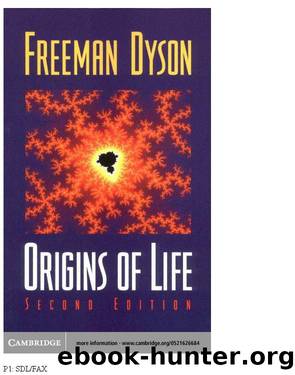Origins of Life by Freeman Dyson

Author:Freeman Dyson [Dyson, Freeman]
Language: fra
Format: epub
ISBN: 0511035594
Published: 0101-01-01T00:00:00+00:00
P1: AKA
CB218/Dyson
CB218-03
June 4, 1999
9:46
CHAPTER THREE
A Toy Model
THE MEANING OF METABOLISM
This chapter describes my own attempt to understand the Oparin
theory of the origin of life. The essential feature of the Oparin theory is that it has life beginning with metabolism rather than with precise
replication. In this chapter I shall use the phrase âOparin theoryâ to
include both the original Oparin theory and the later versions pro-
posed by W ächtersh äuser and others. The Oparin theory as Oparin
proposed it made no attempt to be quantitative. I am trying to place
the theory within a framework of strict mathematics so that its con-
sequences can be calculated. The essential difficulty arises because
metabolism is a vague and ill-defined concept. There is no such dif-
ficulty with the concept of replication. Replication means exactly
what it says. To replicate a molecule means to copy it, either exactly
or with a stated margin of error. Starting from this well-defined con-
cept, Manfred Eigen was able to formulate his theory of the origin of
life, which is in fact a theory of the origin of replication, as a system of equations that can be solved with a computer. Eigenâs equations
describe the evolution with time of populations of molecules sub-
ject to nonlinear laws of replication. When we try to formulate in
a similarly exact fashion the theory of Oparin, which is a theory of
the origin of metabolism, we run immediately into the problem of
defining what we mean by metabolism.
Doron Lancet has tackled this problem by studying computer
models of the evolution of molecular populations, which he calls
replicative-homeostatic early assemblies (RHEA). In these models,
48
P1: AKA
CB218/Dyson
CB218-03
June 4, 1999
9:46
A Toy Model
49
metabolism is defined in a general way as the evolution of a pop-
ulation in which some of the molecules catalyze the synthesis of
others. He finds conditions under which populations can evolve
to a high and self-sustaining level of catalytic organization. Many
other computer studies of the evolution of metabolism have been
published. The results are summarized in a recent review article
(Segr é and Lancet, 1999). My own model of molecular evolution
is a very special case of a RHEA model. My model has an antique
flavor because its behavior is simple enough to be calculated with
pencil and paper rather than with computer simulations.
I reduce the Oparin theory to a mathematically precise form in
two stages. The first stage is a formal description of molecular pop-
ulations treating them like a classical dynamical system and making
the dynamical equations precise but leaving the laws of interaction
completely general. The general theory of molecular systems ob-
tained in this way allows us to define what we mean by the origin of
metabolism but does not allow us to predict under what conditions
metabolism will occur. The second stage consists of the reduction
of the general theory to a toy model by the assumption of a sim-
ple and arbitrary rule for the probability of molecular interactions.
The entire intricate web of biochemical processes is replaced in the
model by a couple of simple equations. The habit of constructing
toy models of this sort is one to which theoretical physicists easily
become addicted. When the real world is recalcitrant, we build our-
selves toy models in which the equations are simple enough for us
to solve.
Download
This site does not store any files on its server. We only index and link to content provided by other sites. Please contact the content providers to delete copyright contents if any and email us, we'll remove relevant links or contents immediately.
| Cell Biology | Developmental Biology |
| Entomology | Marine Biology |
| Microbiology | Molecular Biology |
| Biostatistics |
Sapiens: A Brief History of Humankind by Yuval Noah Harari(14248)
The Tidewater Tales by John Barth(12608)
Mastermind: How to Think Like Sherlock Holmes by Maria Konnikova(7224)
Do No Harm Stories of Life, Death and Brain Surgery by Henry Marsh(6887)
The Thirst by Nesbo Jo(6826)
Why We Sleep: Unlocking the Power of Sleep and Dreams by Matthew Walker(6618)
Life 3.0: Being Human in the Age of Artificial Intelligence by Tegmark Max(5474)
Sapiens by Yuval Noah Harari(5293)
The Longevity Diet by Valter Longo(5017)
The Body: A Guide for Occupants by Bill Bryson(4974)
The Rules Do Not Apply by Ariel Levy(4852)
The Immortal Life of Henrietta Lacks by Rebecca Skloot(4525)
Animal Frequency by Melissa Alvarez(4394)
Why We Sleep by Matthew Walker(4359)
The Hacking of the American Mind by Robert H. Lustig(4318)
Yoga Anatomy by Kaminoff Leslie(4303)
All Creatures Great and Small by James Herriot(4231)
Double Down (Diary of a Wimpy Kid Book 11) by Jeff Kinney(4206)
Barron's AP Biology by Goldberg M.S. Deborah T(4096)
